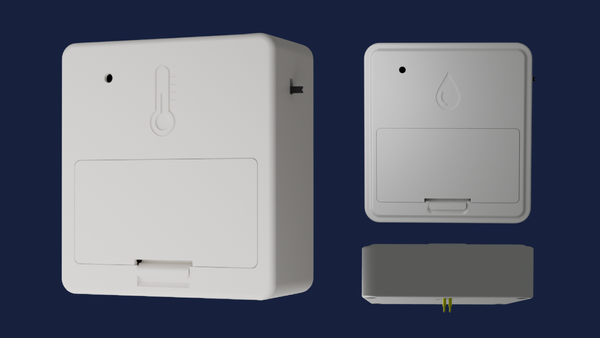Understanding Cabin Humidity: Why 45% Is the Magic Number

Canadian cabins face two extremes: the damp season (spring) that invites mould and very dry winters when frigid outdoor air contains almost no moisture. Holding indoor relative humidity (or RH) near 45 percent is the sweet spot that protects the building, the furnishings, and the people inside.
What Relative Humidity Really Means
Relative humidity (RH) compares how much water vapour is in the air to how much the air could hold at the same temperature. Warm air carries more moisture than cold air, so identical RH readings can feel very different in July versus January.
Building‑science agencies and health organisations recommend keeping dwellings between 30 and 50 percent RH. The midpoint—about 45 percent—is high enough to prevent wood from shrinking yet low enough to discourage mould, dust mites, and most bacteria.
Risks When Humidity Climbs Above 60 Percent
- Mould growth: Spores activate once RH exceeds roughly 60 percent, especially on cool surfaces where condensation appears. Keeping RH below this point ensure your cabin remains mould-free.
- Structural decay: Persistent moisture softens log fibres, plywood, and drywall paper. You might not notice this week, this month or even this year - but it will become a problem in the long run.
- Health concerns: Mould fragments and by‑products can irritate airways and trigger allergies. You're at the cabin to relax - not suffer!
Why Humidity Below 35 Percent Also Creates Problems
During cold Canadian winters, outdoor air warmed indoors can drop RH to 20 percent or less. Prolonged dryness can lead to:
| Wood Feature | Typical Issue Below 35 % RH |
|---|---|
| Wide‑plank floors | Seasonal gaps and squeaks |
| Cabinet doors | Warping or misalignment |
| Log‑corner seals | Caulking cracks and air leaks |
Wood seeks an equilibrium moisture content that corresponds to about 45 percent RH at 20 °C, so maintaining that level minimises expansion‑and‑shrink cycles.
Low RH also dries skin, nasal passages, and increases static electricity - as any Canadian from the prairies is well familiar with.
Measuring Cabin Humidity
There are a few options to keep track of your cabin's humidity - some better than others.
- Analog hygrometer: Affordable but requires seasonal calibration with a salt test. You're only able to check the values when you're physically at your cabin.
- Digital thermo‑hygrometer: Around $40, ±2 percent accuracy, some models record daily highs and lows. Likewise, most don't store data to check on later so you'll miss out when you're not there.
- Remote sensor: Devices such as CabinPulse track humidity with accurate sensors and saves readings to an online dashboard for you to review at any time - a safeguard when you are away for months at a time.
Place any sensor at chest height, away from exterior walls and direct sunlight for the most reliable reading.
| Humidity Problem | Actions You Can Take Before Leaving | Upgrades Worth Installing for Long Absences |
|---|---|---|
| Air Too Damp ( > 55 % RH) | • Run a timed exhaust‑fan purge. Let bathroom or utility‑room fans run for 30 minutes just before you lock up. • Store desiccant packs in closed spaces. Large silica‑gel tubs inside closets and under sinks absorb residual moisture for weeks. • Shut off the water main. Eliminates hidden leaks, a common cause of rising RH. | • Smart dehumidifier with built‑in humidistat and hose to a floor drain. Set it to 45 % RH; it cycles automatically year‑round. • Heat‑recovery ventilator (HRV) on a programmable timer. Exchanges stale indoor air for drier outdoor air without major heat loss. • Gutter extensions and proper grading. Keeps spring melt and storm water from seeping into the crawl space where it can raise indoor RH. |
| Air Too Dry ( < 35 % RH in winter) | • Add shallow water trays near heat sources. A steel kettle on the wood stove or a ceramic bowl on a register releases moisture gradually. • Leave interior doors open. Promotes even moisture distribution so individual rooms do not over‑dry. | • Console‑style evaporative humidifier with automatic shut‑off. Fill the reservoir before leaving; the unit maintains target RH and then stops. • Whole‑house steam humidifier linked to the furnace. Once set to 45 %, it operates only during heating calls; little attention needed between service intervals. |
| Need Continuous Oversight | • Place a battery thermometer‑hygrometer in the main living area. Check readings the moment you arrive. | • Install a cellular sensor like CabinPulse with alert thresholds. It sends text and email warnings if RH drifts outside your custom threshold, giving you time to ask a neighbour or caretaker to intervene before problems escalate. |
Quick Pre‑Departure Routine
- Set dehumidifier or humidifier to 45 % RH and confirm water supply or drain hose is secure.
- Run exhaust fans (bathroom and kitchen) on a 30‑minute timer to flush indoor moisture.
- Verify downspouts are clear and direct water at least two metres from the foundation.
- Turn off the main water valve and open a low‑point tap for a moment to relieve pressure.
- Check CabinPulse before you leave and make sure it's plugged in and reporting data.
By combining a few low‑tech habits with one or two automated upgrades, you can keep your cabincomfortably close to 45 percent relative humidity all year—protecting finishes, preventing mould, and avoiding unpleasant surprises when you unlock the door in the spring.
Seasonal Checklist
- Spring thaw: Inspect and repair vapour barriers in crawl spaces; standing water quickly drives RH up.
- High summer: Close windows on humid days before leaving; night‑time condensation can spike RH.
- Heating season: Use humidifiers only until RH approaches 45 percent, then turn them off to avoid window condensation and ice buildup.
Key Takeaways
- Aim for 45 percent RH all year.
- Measure before you adjust. Guessing often leads to over‑correction.
- Address both high and low extremes. Mould and wood shrinkage are equally costly.
- Document trends. A week‑long humidity log provides far more insight than a single snapshot.
By monitoring and fine‑tuning indoor moisture, you will keep floors quiet, walls clean, and winter air comfortable—ensuring that your cabin remains a healthy retreat in every season.




